04 | BIOCHROMES¶
This week's aim is to learn how to work with biodyeing and understanding biochromes, as well as being introduced to alternative biochromes suchas bacterial chromes.
RESEARCH | IDEATION¶
This project was a lot about learning how to dye with bio colours, thus the research has not been extensive, but I did look into designer who work with locally sourced dyes such as SIGMUNDUR ATELIER and LISA HÜLS. I also looked into how seaweed material can be dyed here I was greatly inspired by VIOLAINE BUET. I am also very excited about dyeing with bactria, so I put in all the sources that works with this subject.
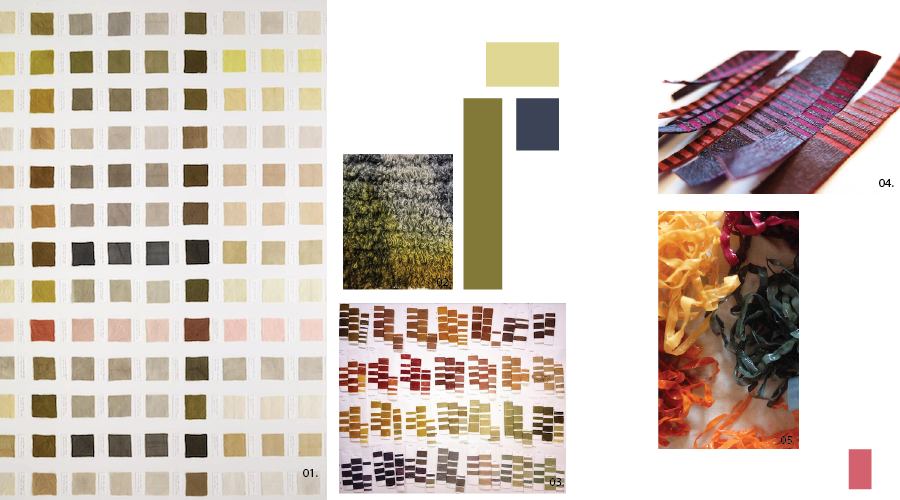
- 01 | LOCALLY SOURCES BIO COLOUR LIBRARY BY SIGMUNDUR ATELIER
- 02 | BIOCOLOURING WITH RED ONION IN DIFFERENT MATERIAL MIXING COLD AND WARM BATHS BYLISA HÜLS
- 03 | BIO COLOURING DIARY BY LISA HÜLS
- 04 | DYED SEAWEED BY VIOLAINE BUET
- 05 | DYED SEAWEED BY VIOLAINE BUET
- 06 | LIVING PGMENTS
- 07 | BIOCOLOUR
- 08 | BOTANICAL COLOURS
- 09 | ELECTRONICA
- 10 | LIVING COLOUR
- 11 | OPENCELL
PROCESS | WORKFLOW¶
This week we have been going through the basics step of biodyieing, which can be divided into the following steps
- 01| SCOURING
- 02| MORDANTING
- 03| PREPARING THE DYEBATH
- 04| DYE

- 01| OVERVIEW OF DYE PROCESS AND RESULT
- 02| WOOL SCOURING
- 03| FIBER SCOURING
- 04| DYE BATHS AND DRIED DYE MATTER
- 05| LUPIN LEAVES
- 06| MADDER DYE BATH
- 07| RHUBARB DYE BATH
- 08| RINSING AND DRYING OF COLOURING
GOOD TO KNOW | SCOURING¶
Scouring means cleanig the fabrics removing dirt, coatings and oils from the fibers and textiles in order to enable them to absorb the dyestuff. If the fibers are coated with other material, the dye will not be able to enter the fiber. A scouring agent is applied to a bath of water which is then heated until its simmering, the fabrics are then added to the solution for at least an hour.
| MATERIAL | AMOUNT OF MATERIAL | SCOURING AGENT | AMOUNT OF SCOURING AGENT 2% WOF weight of material |
|---|---|---|---|
| WOOL | 810 g | SODA ASH | 16,2 g |
| SILK | 6 g | ||
| COTTON | 18 g | ||
| LINNEN | 60 g | SODA ASH | 1,68 g |
The wool was washed twice, the second time with some wool detergent, as the lanoline amount was very high after the first scouring. Unfortunately there was a bit too much mechanical action applyied when we scourd the second time, which made it felt, eventhough it was not that warm. So when working with wool remember to not apply too much stiring and not too much heat.
GOOD TO KNOW | MORDANTING¶
Mordanting means perparing the fibers for absobing the dyestuff. The mordant can be many components, the one we used was Alum. The mordant agent is applied to a bath of water which is then heated until its simmering, the fabrics are then added to the solution for at least an hour.
| MATERIAL | AMOUNT OF MATERIAL | SCOURING AGENT | AMOUNT OF SCOURING AGENT 2% WOF weight of material |
|---|---|---|---|
| WOOL | 810 g | SODA ASH | 16,2 g |
| OTHER FIBERS WERE PUT IN SAME BATH | |||
| SILK | 6 g | ||
| COTTON | 18 g | ||
| LINNEN | 60 g | SODA ASH | 1,68 g |
GOOD TO KNOW | PREPARING THE DYE BATH¶
The dye bath is extracting the pigment reciding in the plant, root, fungi or other matter by putting it in water under heat. Though never boiling, only simmering. The amount of water used is just to cover the dye stuff.
| DYE STUFF | |
|---|---|
| MADDER ROOTS | |
| RUBARB LEAVES | |
| LUPINS | |
| COCHENILE | |
| RED ONION PEEL | |
| SEAWEED |
GOOD TO KNOW | DYE¶
Dyeing means putting a scoured and mordanted fabric into a strained dye bath under heat for min an hour. Never boiling, just simmering. It is also pissible to cold dye, which means leaving the fabric in for longer in the cold dyebath.
| DYE STUFF | AMOUT OF DYE STUFF | AMOUNT OF FIBER | COLD OR WARM DYE BATH |
|---|---|---|---|
| MADDER ROOTS | 50g | 150g | WARM |
| RUBARB LEAVES | 160g | 150g | WARM |
| LUPINS | 320 | 160g | WARM |
| COCHENILE | 10g | 150g | WARM |
| RED ONION PEEL | 75g | 150g | COLD |
| SEAWEED | 310g | 150g | WARM |
GOOD TO KNOW | MODIFYERS¶
Modification of colours caqn be acieved in various ways depending on the compostion of the dye stuff. If you are colouring with red kale, the colours can be changed by altering the pH, i.e. by adding an alkaline solution or an acidic solution on the coloured fabric or into the dye bath. Another type of modification, which "saddens" the colours, can also be achived by iron modificatio. This can be achived by creating an iron slolution or by adding rusty iron pieces directly on the fabric as a pattern. We made an iron solution and then a 10% solution to treat the dyed samples with.
| INGREDIENTS FOR 100% SOLUTION | AMOUNT |
|---|---|
| IRON POWDER, FE | 2g |
| 4% VINEGAR | 200ml |
| SODIUM CARBONATE, NA2CO3 | 1g |
GOOD TO KNOW | PIGMENTS¶
The leftover dye baths can be used to make pigments and incs. Pigments are generated by percipitation the colourants in the left over dye baths. This is achived by creating a solution of alum, sodium carbonate and the dye baths, the solution should then be allowed to sediment, fultered through a filter and thereafter dryed it in a drying cabinet to become a compound. A compund that can be used as a pigment to create incs or dyepaste. For this we both used the rests of the dye baths, but we also tried to use some new baths.
| INGREDIENTS | AMOUNT |
|---|---|
| ALUM | 20g |
| DYE BATH | 200ml |
| SODIUM CARBONATE, NA2CO3 | 5g |
STEP BY STEP FOR MAKING PIGMENT
- Dissolve the alun in boiled water.
- Add it to the dye bath.
- Dissolve the sodium carbonate in boiled water.
- Add it SLOWLY to the solution. It will foam!
- Wait for it to sit.
- strain
- Drye
| DYE BATH | AMOUT OF DYE STUFF | AMOUNT ALUM 10% OF DYE BATH | AMOUNT OF SODIUM CARBONATE 2.5% |
|---|---|---|---|
| DRIED WAXY MUSHROOMS | 355g | 35,5g | 8,88g |
| NOT DRIED WAXY MUSHROOMS | 345g | 34,5g | 8,6g |
| MYSTERY MUSHROOM | 288g | 28g | 7,2g |
| SEAWEED 01 | 328g | 28,8g | 8,2g |
| SEAWEED 02 | 206g | 20g | 5,15g |
| REUSED RED ONION PEEL AND MADDER BATH | 350g | 35g | 8,75g |
| REUSED LUPIN BATH | 350g | 35g | 8g |
GOOD TO KNOW | INKS¶
The pigments created above can be used to make inks by adding water to the pigments, however the recidual byebaths can also be ruduced to greate inks. The reduction is created by heating the dyebath.
GOOD TO KNOW | INDIGO¶
Another way of dyeing is with an indigo VAT. We used the 1, 2, 3 method. The indigo dyeing is made via a Oxidation-Reduction chemical reaction that removes and adds oxygen. This is visible bu acolour change from yellow to blue, when the fabric is pulled out of the solution it is yellow, but rapidly turns blue as the indigo pigment is oxidised. A VAT dye means that the dye is insoluble in water and should therefore be reduced in an alkaline solution before adding the fabric. The pH should be between 10-14.
| INGREDIENTS | PROCENTILE AMOUNT | AMOUNT IN CURRENT BATH |
|---|---|---|
| WATER | 1 | 1,5l |
| INDIGO | 10% OF AMOUNTOD WATER | 15g |
| CALCIUM HYDROXIDE | 2x AMOUNT OF INDIGO | 30g |
| FRUCTOSE | 3x AMOUNT OF INDIGO | 45g |
STEP BY STEP FOR INDIGO WAT, 1, 2, 3
- Make paste with boiled water and indigo, OBS the particles will not dissolve.
- Dissolve Calcium Hydroxide and Fructose in boiled water.
- Mix Indigo paste into the solution.
- Mix until the solution is yellow, trying not to add any oxygen while mixing.
- Feed with fructose until the pH is between 10-14·
- Stir the solution until there is blue foam on the top.
- Using gloves dip the fabric into the VAT without adding extra oxygen to the solution.
- Massage the pigment into the fabric.
- Make sure not to drip the residual water from the fabric into the VAT as this is oxidised.
- Dip in vinegar solution to stop the oxidation.
GOOD TO KNOW | COLOURING SEAWEED¶
I also used the waste dyebaths to colour the cut-offs of my seaweed from WEEK 03, I realised I could re-make a new material, as the seaweed paper is dissolved in the water. So the waste was put in the waste baths and absorbed the dyed water. I tryed this with cochenille, red onion, madder, rubarb and lupin, where the cochenille was by far the most effective, mainly because the pink colour is wery visible trhough the green of the seqaweed.

- 01| ONION DYE
- 02| MADDER DYE
- 03| RHUUBARB DYE
- 04| COCHENILE DYE
GOOD TO KNOW | BACTERIAL CHROMES¶
Finally we also got to work with the bacterial dyes, which is a whole other way of thinking in dyes, as it is the bacteria's exrements that creates the colours as the bacteria grows and lives on the fabric. We went to Bio-Pol in Skagatrönd, to see the facilities and sterilize our equipment. Catherine Euale showed us the ways to collaborate with the bacteria to create the best environment for it and thus for the dye. The bacteria we used is called janthinobacterium lividum.


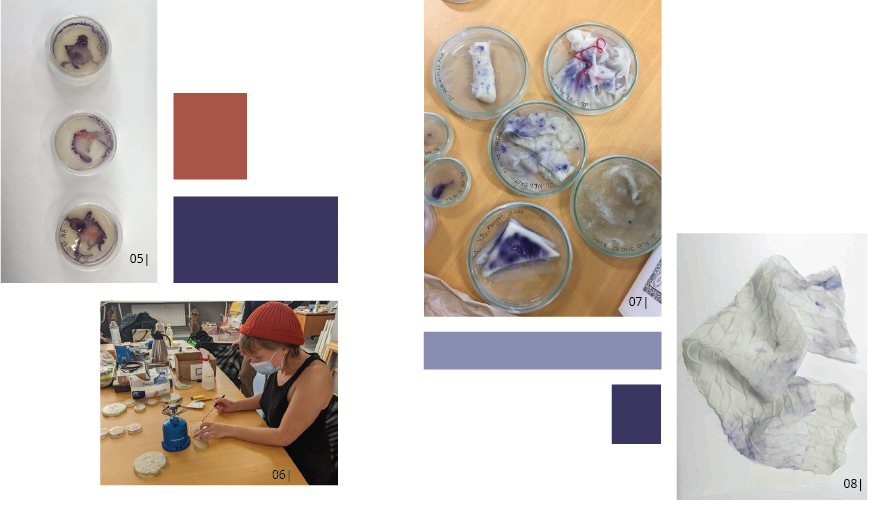
- 01| BIO-POL LAB
- 02| PRESSURE COOCKING
- 03| POURING THE AGAR
- 04| INOCULATION
- 05| GROWING BACTERIA
- 06| TRANSFERRING BACTERA TO FABRIC SAMPLE IN LB
- 07| GROWING BACTERIA ON FABRIC
- 08| FINAL SAMPLE
| INGREDIENTS | PROCENTILE AMOUNT | AMOUNT IN CURRENT BATH |
|---|---|---|
| WATER | 1 | 200ml FOR EACH SOLUTION |
| AGAR | 2,5% OF AMOUNT OF WATER | 5g |
| LB BROTH | 2,5% OF AMOUNT OF WATER | 5g |
STEP BY STEP FOR COLLABORATING WITH BACTERIA
- Make the agar ans LB broth.
- Sterilize all the tools and the agar and LB broth in the pressure coocker for 30 min at 121 psi.
- Pour the agar in sterilised petri dishes under a bunsen flame and on an alcohol sterilised surface.
- Let the agar cool down to a jell.
- Inogorate the bacteria, under a bunsen flame and on an alcohol sterilised surface.
- Use a sterialised inoculation loop to scoop up the bacteria.
- Transfere the bacteria to the agar jell in a cross pattern.
- Close the lid of the petri dish with the parafilm tejp.
- Let it grow.
- Manipulate a fabric sample.
- PLace the fabric in petri dish.
- Pour the LB broth over the sample.
RESULTS | MADDER¶
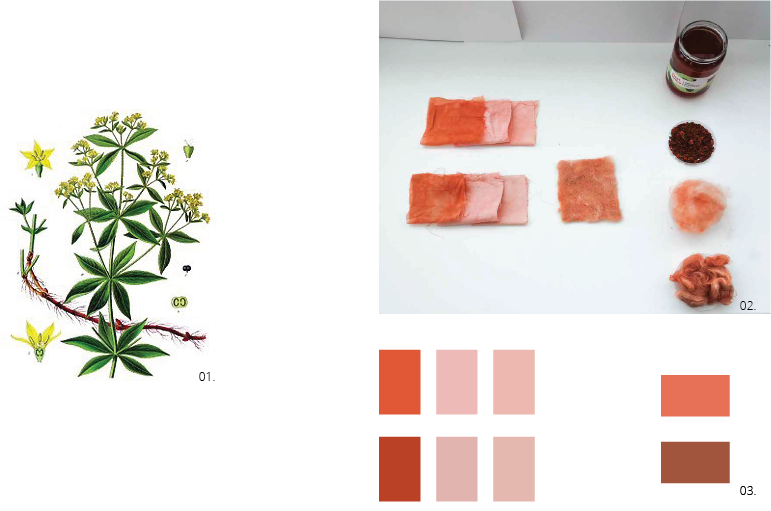
- 01| MADDER
- 02| RESULT OF DYEING WITH MADDER
- 03| COLOUR PALETTE, TOP LEFT: PLAIN MADDER IN SILK, LINNEN, COTTON, BOTTOM LEFT: IRON MORDANTED MADDER IN SILK, LINNEN, COTTON. TOP RIGHT: PLAIN MADDER IN WOOL, BOTTOM RIGHT: IRON MORDANTED MADDER IN WOOL.
RESULTS | RUHBARB¶

- 01| RHUBARB
- 02| RESULT OF DYEING WITH RHUBARB LEAVES
- 03| COLOUR PALETTE, TOP LEFT: PLAIN RHUBARB IN SILK, LINNEN, COTTON, BOTTOM LEFT: IRON MORDANTED RHUBARB IN SILK, LINNEN, COTTON. TOP RIGHT: PLAIN RHUBARB IN WOOL, BOTTOM RIGHT: IRON MORDANTED RHUBARB IN WOOL.
RESULTS | LUPIN¶
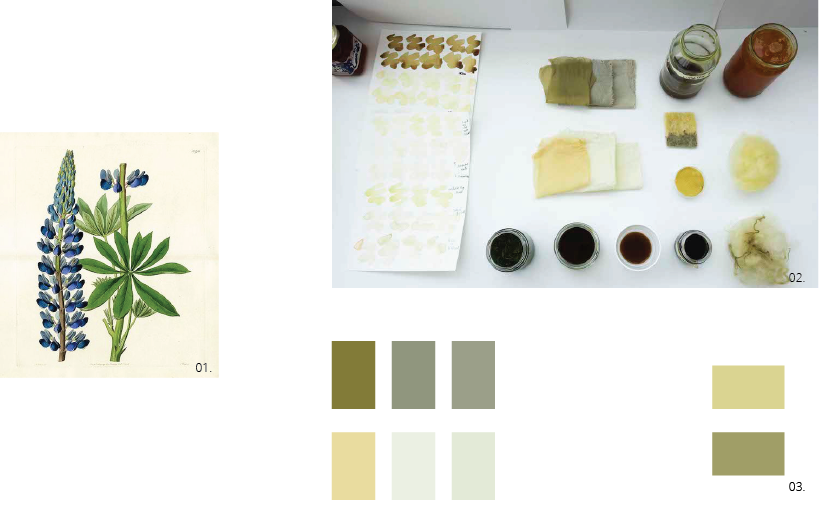
- 01| LUPIN
- 02| RESULT OF DYEING WITH LUPIN LEAVES
- 03| COLOUR PALETTE, TOP LEFT: PLAIN LUPIN IN SILK, LINNEN, COTTON. BOTTOM LEFT: IRON MORDANTED LUPIN IN SILK, LINNEN, COTTON. TOP RIGHT: PLAIN LUPIN IN WOOL. BOTTOM RIGHT: IRON MORDANTED LUPIN IN WOOL.
RESULTS | COCHENEAL¶

- 01| COCHINEAL
- 02| RESULT OF DYEING WITH COCHINEAL
- 03| COLOUR PALETTE, TOP LEFT: PLAIN COCHINEAL IN SILK, LINNEN, COTTON, BOTTOM LEFT: IRON MORDANTED COCHINEAL IN SILK, LINNEN, COTTON. MIDDLE: PLAIN COCHINEAL IN SEAWEED. TOP RIGHT: PLAIN COCHINEAL IN WOOL, BOTTOM RIGHT: IRON MORDANTED COCHINEAL IN WOOL.
RESULTS | RED ONION¶
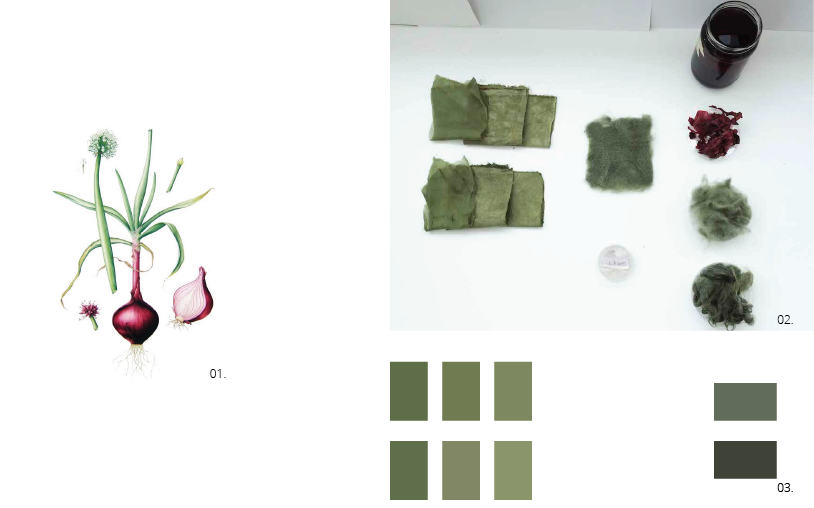
- 01| RED ONION
- 02| RESULT OF DYEING WITH RED ONION PEEL
- 03| COLOUR PALETTE, TOP LEFT: PLAIN ONION IN SILK, LINNEN, COTTON, BOTTOM LEFT: IRON MORDANTED ONION IN SILK, LINNEN, COTTON. TOP RIGHT: PLAIN ONION IN WOOL, BOTTOM RIGHT: IRON MORDANTED ONION IN WOOL.
RESULTS | KELP FUCUS SERRATUS¶
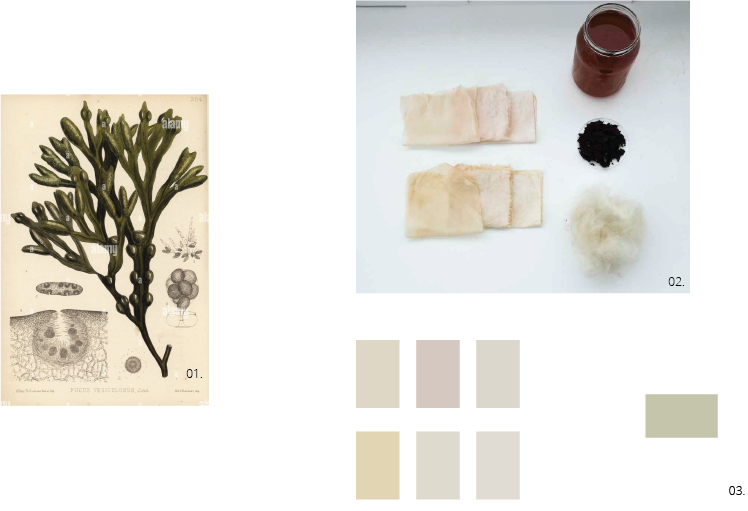
- 01| FUCUS SERRATUS
- 02| RESULT OF DYEING WITH FUCUS SERRATUS
- 03| COLOUR PALETTE, TOP LEFT: PLAIN FUCUS SERRATUS IN SILK, LINNEN, COTTON, BOTTOM LEFT: IRON MORDANTED FUCUS SERRATUS IN SILK, LINNEN, COTTON. TOP RIGHT: PLAIN FUCUS SERRATUS IN WOOL, BOTTOM RIGHT: IRON MORDANTED FUCUS SERRATUS IN WOOL.